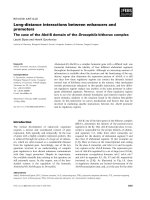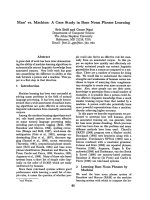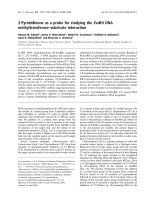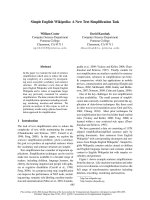Báo cáo khoa học: "Constituent-Based Morphological Parsing: A New Approach to the Problem of Word-Recognition" pdf
Bạn đang xem bản rút gọn của tài liệu. Xem và tải ngay bản đầy đủ của tài liệu tại đây (550.73 KB, 8 trang )
Constituent-Based Morphological Parsing:
A New Approach to the Problem of Word-Recognition.
Richard Sproat
Linguistics Department
AT&T Bell Laboratories
600 Mountain Ave
Murray Hill, NJ 07974.
Barbara Brunson*
AT&T Bell Laboratories
and
Department of Linguistics
University of Toronto
Toronto, Ontario, Canada M5S 1A1.
Abstract
We present a model of morphological
processing which directly encodes prosodic
constituency, a notion which is clearly crucial
in many widespread morphological processes.
The model has been implemented for the
Australian language Warlpiri and has been
successfully interfaced with a syntactic parser
for that language (Brunson, 1986). We
contrast our approach with approaches to
morphological parsing in the KIMMO
framework.
1. Introduction
The "Two-Level" Model of morphological
processing developed by Kimmo Koskenniemi
(1983), henceforth KIMMO, has spawned
much subsequent research in the same
framework (Karttunen, 1983; inter alia).
Important design features of this model
include a set of morpheme lexicons and a set
of parallel finite state transducers which
implement phonological rules mapping surface
strings to lexical representations. Not only are
phonological rules finite state, but the control
structure of the model is itself finite state.
Two criticisms of this model can be put forth.
First, KIMMO is not guaranteed to be
computationally efficient (Barton, 1986).
Second, there are many interesting
morphological phenomena that KIMMO
cannot cover without significantly redesigning
the model. In this paper we will address the
second point. We will present a model of
word-structure recognition which, unlike the
KIMMO model, makes heavy use of prosodic
constituent structure. Not only is reference to
prosodic constituency necessary to provide a
principled way of dealing with certain
morphological processes, but such an approach
to phonological processing is crucial for any
interface of current parsing systems with
speech recognition systems (Church, 1983).
The model has been implemented for the
Australian language Warlpiri. We will
describe how the parser works, and how it
handles morphological phenomena that would,
at best, require inelegant mechanisms within
the KIMMO model. We will also show how
we can handle morphological phenomena that
are not exemplified in Warlpiri but which are
of a similar ilk.
2. Two Facts about Morphology
We will now consider two issues in
morphology, namely prosody and the non-
isomorphism of syntactic and phonological
structure. We maintain that these are are
central to the task of a morphological analyzer
and, hence, have incorporated them into our
model.
2.1 The Relevance of Prosody to Morphology
It has become increasingly evident from
research within Generative Linguistics that
65
morphology cannot be limited to the
concatenation and subsequent modification of
strings of segments, but must recognize
prosodic constituents devoid of segmental
content (McCarthy, 1979; Levin, 1985).
Work on reduplication I by Marantz (1982) and
by Levin (1985) has argued convincingly that
reduplication involves the preftxation or
suffixation of a prosodic constituent which is
empty of segmental information but which
receives segmental specification by copying the
segmental melody from the base.
Furthermore, it has been suggested that
infLxation 2 must be viewed as prefixation or
suffixation of an affix to a prescribed prosodic
subconstitucnt of a word rather than to the
whole word.
All of this work argues that prosody is a
~ucial component of morphology. It is
necessary, therefore, that morphological
processing systems should have a mechanism
for dealing with prosody in a general way.
KIMMO does not provide such a mechanism.
Instead, it assumes that the problem of
morphological recognition is one of matching
some input
string
to a set of lexical
strings.
Prosodic considerations do not even enter the
picture. The KIMMO model probably could
be extended in various ways to cover such
phenomena, but such extensions would
constitute a significant change in the theory.
Reduplication would require a particularly
significant revision since it both involves
reference to prosodic structure as well as a
copy mechanism which is not finite state in
any interesting sense. Note that although
reduplication is strictly speaking bounded by
the maximal size of some well-defined
prosodic unit, and hence is
effectively
finite
state, finite state recognition for reduplication
would require the anticipation m i.e.,
precompilation m of all possible
reduplicative-affix/stem sequences.
Reduplication in natural language involves
recognition of the language ww, a language
which is well known not to be regular. As we
shall see, reduplication is handled in our
model by directly encoding prosody, and
allowing for a bounded matching mechanism.
2.2 The Non.Isomorphism of Morphophonology
and Morphosyntax
Another fundamental property of morphology
is the fact that the structure required for the
phonology is not necessarily isomorphic to the
structure required for the morphosyntax. This
point has been argued extensively in work such
as Marantz (1984) and Sproat (1985). For
example, in Warlpiri a number of clitics which
are suffixes as far as the phonology is
concerned (i.e., they undergo Vowel
Harmony 3 with the word to which they attach)
are separate words from the point of view of
the syntax. For instance, the auxiliary in
Warlpiri tensed clauses generally occurs as the
second syntactic constituent of the sentence;
phonologically, however, it is part of the first
constituent. This phenomenon is by no means
limited to scattered examples in a few
languages, but apparently represents a very
important generalization about the interaction
of phonology and syntax in the morphology
they operate over different, though related
structures. We propose to capture this
observation by making the syntactic module of
the parser largely independent of the
phonological module, as we shall outline
below.
3. A Description of the Warlpiri Parsing System
The main reason for choosing Warlpiri for our
test domain is that Warlpiri provides a
sufficient number of interesting morphological
and phonological phenomena m such as
Vowel Harmony and reduplication without
having an overabundance of phonological rules
(unlike Finnish which has roughly 20 rules in
the KIMMO description). It is thus possible
to build a system which has a reasonable
coverage of the morphological and
phonological processes evident in the
language. At the same time, in order to cover
the Warlpiri data the system must be designed
to handle morphological processes whose
description crucially depends upon prosodic
constituency.
The task of the morphophonological parser is
to f'md out where the word boundaries are and
then where the morphemes are. It receives as
input a stream of segments and a parallel
stream of suprasegmental stress information.
66
The input streams may represent a single word
or they may represent a sequence of words; in
any case, no word or morpheme boundaries
are provided in the input. The parser checks
to see if a morpheme sequence can correspond
to the input stream by verifying that the
appropriate phonological rules apply in the
appropriate domains. It then passes a
'flattened representation' of the morphological
structure, consisting merely of the morphemes
in their linear order with word boundaries, off
to the syntactic parser.
The syntactic parser for Warlpiri which we
have been using is due to Brunson (1986).
This parser was designed to take as input a
sequence of morphemes rather than a sequence
of fully formed words as most syntactic
parsers do. Such a parser embodies our belief
that the the task of building a
syntactic
representation for words should be handled by
the syntactic parser and not by a separate
morphosyntactic parser. In this way clitics can
readily be identified in their syntactic roles
independent of their phonological
constituency.
Let us now turn to a concrete example from
Warlpiri and show how we parse the
morphemes and pass on the 'flattened
representation' to the syntactic parser.
4. Parsing the
Morphophonology
We will take as an example for discussion the
word /pangupangurnu/, which means 'dug
repeatedly' and which is composed of the
morphemes Reduplication + pangi + rnu, (pangi
= 'dig', rnu 'past') (Nash, 1980), where
Reduplication is the verbal reduplication
morpheme. Of interest in this example are
regressive Vowel Harmony 4, and, of course,
reduplication. The input consists of the stream
of segments and a stream of stressesS:
pangupangu r nu
1 2
There is a question of course as to whether
one could reliably derive stress information
from connected speech input. Preliminary
studies of Warlpiri intonation suggest that
main word stress at least is extractable from
acoustic input (see Figure I). We presume,
however, that other phonetic facts may also
help determine the prosody; see Church (1983)
for a method for determining English prosodic
constituents from observable allophonic
variation.
The f'n'st task is to find the prosodic
constituents, i.e. to find where the syllables
are, where the feet ~ are, and where the
prosodic words are. The particular parsing
algorithm we adopt is that of Church (1983),
which is not left-to-right, but nothing hinges
on this decision; indeed, as we point out
below, we will ultimately want a left-to-right
parsing algorithm so that the phonological and
syntactic parsing can be interleaved. The
prosody of Warlpiri is simple in that syllable
types are limited and phonological words are
reliably left-stressed. In the particular
example, the parser will tell us that the
syllables are /pa/, /ngu/, /pa/, /ngu/ and /rnu/
(the sequences ng and rn represent single
segments), that the feet are /pangu/ and
/pangurnu/ and that there is a single prosodic
word, namely/pangupangurnu/.
Having done the prosody, we proceed to look
up the morphemes which might plausibly
comprise the word. Warlpiri quite generally
requires that morphemes be syllabifiable
strings. The only exceptions to this are
suffixes which consist of the sequence
[sonorant] [stop] [vowel], for example the
imperfective auxiliary base Ipa. We can
therefore find all possible morphological
decompositions for a word by checking all
[sonorant][stop][vowel] sequences and all
well-formed syllable sequences and seeing if
the strings spanning them correspond to known
morphemes.
Lexical lookup is complicated due to the fact
that the surface string can differ from the
underlying representation of the morpheme in
several ways. This can come about by the
application of phonological rules. We
implement lexical access in such cases by
hashing on underspccified feature
representations. In Warlpiri the only
complication of this sort involves rounding of
high vowels: for example, lexical /i/ may
surface as /i/ or /u/ depending upon the
harmony context. In the verb root pangi will
therefore match the input sequences /pangi/
and/pangu/.
67
~LL] LL]L] _LL~- _
::::: ::: ::::::: ::i~'~[ ii:: !ii
' '::;:~":';"~; i ";'; :'1"~';":'~:::I -l- ;, :;'; -:- I ;_~;,; 4 ;'~: ; ,~" ; :';";'i : ; ";' :
? I'!'!'!"!T' "!!'!'!'T "!'!' :!'!"'~"i!"i 'Ti'?"r'!" Illr-!-!.! ~-!-t.!
iiiiii!!!iiiii~::ii]i::::i!i::ii~::!i:: ::i::i
t i.i ~ ~ ! i ~ ;.! 7.i ~. ~.~.I H :: ! i ! ! i.i H i.~ i.,i.i i i.l.i i i ,
: ,~.i.l.i._~!~.~.~-~ ~.~ "~
I~"- : " " ~' "
i.~.~ ~ ;.i ~.i.i, i i ~ H ; i L.;.~. H :.~.~.;.I., ;
) ,,.; ~ ; |
i
i i iii/iil-iilLi I
i _4 ~.~a.:_: ' ; , . . . ._ _ ~ ~" -,.~_~.,
t ~~'~:~;~'~ ~' ! ii.i.i ii i i.i.~.~ ~!ii~~i i:.i.i, i. i i.i .!.' i i.i.i.i 14 i I~ ~ i.:.i.~ i.:.i.~.ii~~
i i i4 ;.!. ~.i i i ;.~.4.~ ~.4 i ~ ;.;.i.l ~ ~ ~.::.,:.;.~ i i.i ~,
~ - J, ~ i~-~ ~2~: ~: ~"~
iiiii!iiiiiiii~iiiii!!!iii~iiiiiiii!
I{; i!i.ii.ii.~-;-iil.;~.i ;.i.i i.i,.i !.i I~,.i i i.i.~ i:.
i ii!ii~;ii.~ii~,r~i ~'ii i i: t:. i
! iii !ii '~i!i:::i:i::i:! ii ::::~:::~.
,~', ~.:.: ~.;,!.;.:.;.:.~.;.,;~e., ~.:.[.L ;,.LL~ L'r-' .:.i.'.~ i.L-:.~.;.i.
.~ ~ i: i! !:~! i i::::i:: tl ,: ~
~ ~ ~ ~ ._i '~ : ],iJi ~ii~ i-~.,~~;~
::::::::::::::::::::::::::: ,::::!::.
~ ]
~. : : : ~ ~-'~~ T ~ ,,~.~-~~
~]~
~.i.! ~_~-i i.,i i.! ~.i !.i i ! .i i i i-i.,i i ~ .i i i i i.i.i,,:,.~
_~ I:I ~! i:::iii:? il!:illi ~:i:]iii?i
~I L ~.; ~'.~ : i.i ; ; : ~ ;. ~ ~.i ~ ~ i.; ~ ;
~. !::ii Uii ~,::::i: :!iii i~;lii~i;!~iiiiii.
!~iii!iiiiiiiiiiiiiiiiiiiiiii: :
I ' I ' I ' I ' I
0 ~f~ o In 0 ~ 0
~.~ ,~
o.~
~ r,n
~
"
~ 3
w o
o
0 ~ ~0
~-~
g~
~.;
68
Another way in which the surface
representation of a morpheme may differ from
its underlying representation is if it does not
contain any segmental information, but merely
information about prosodic shape. This type
of morphology manifests itself in Warlpiri as
reduplication. Briefly, the verbal reduplicative
prefix is listed as a bimoraic foot: i.e., a foot
of the form CV(C)(C)V. Whenever we see
such a constituent, we posit the existence of
verbal reduplication
subject
to immediate
verification if it matches the phonological
material to its right. For Warlpiri, "matches"
is "string equivalent to". For other languages,
a more sophisticated notion of matching would
be necessary. This would be necessary when
phonological rules apply to only one part of
the reduplicated pair. In/pangupangurnu/, the
first sequence /pangu/ is a bimoraic foot, and
furthermore it matches appropriately with the
sequence to its right. Therefore we can here
posit the existence of a verbal reduplicative
affix.
Having found the possible morphemes, we
have a lattice of morphemes spanning the
input. In the example case, we have a lattice
with a unique path comprising
Verbal-
Reduplication, pangi, rnu.
We now wish to
check that, from a phonological point of view
alone, the affixes can be combined in the
order given. That is, the affix path must be
well-formed according to a
morphophonological grammar for Warlpiri.
We can state the morphophonological
grammar simply as follows (where VHD
stands for 'Vowel Harmony Domain'):
Word - (Prefix) VHD
VHD
-
[Root Suffix*] N Vowel-Harmony
The first rule indicates that a word consists of
an optional prefix followed by a Vowel-
Harmony-Domain; the second claims that a
Vowel-Harmony-Domain is a string analyzable
as a root followed by some number of suffixes
taken together with the Vowel Harmony
process. We check the application of
phonological rules, such as Vowel Harmony,
by checking to see that the sequence of surface
segments can be paired with the sequence of
lexical segments in the underlying morphemes
and that the surface string is well-formed
according to the statement of the rules. This
we do by a mechanism formally equivalent to
the finite state transducer mechanism of the
KIMMO model. In particular, we implement
phonological rules as rejection sets
(Koskenniemi, 1983), which are stated as
regular expressions over the set of possible
lexical/surface segment correspondences.
However, in our model, phonological rules are
defined for particular domains of application
rather than continuously applying as in the
KIMMO parser for Finnish. For example,
Warlpiri Vowel Harmony is defined to apply
over the sequence consisting of a root followed
by its suffixes, but not over preffLxes. ~
Having established the identity of the
morphemes of the word, and having further
established that each potential morphological
analysis is well-formed from a phonological
point of view m i,e, the morphemes are in the
right order and the relevant phonological rules
have applied correctly over the appropriate
domains n we then pass the morphological
analysis
off to
the syntactic parser. More
specifically, we pass off what we call a
"flattened representation" which encodes only
the information as to what order the
morphemes occur in and where the word
boundaries are. Arguably the syntactic parser
does need to know where the phonological
words and phrases are, but the fine details of
the phonological structure are not needed.
The potential non-isomorphism between
phonological and syntactic structure is derived
from the narrow bandwidth of the channel
between the phonological and syntactic
components of the parser. This non-
isomorphism is illustrated when a morpheme
which is phonologically an affix is syntactically
a separate word n this is the case with
cliticization.
Also exemplary of the division of duty
between the morphophonological parser and
the syntactic parser is the dual status of
subcategorization in Warlpiri. For example,
the ergative case suffix has two forms m/rlu/
and /ngku/. Both are subcategorized to occur
with nominals, a fact that is crucial in the
projection and selection of syntactic
constituency. The choice between /rlu/ and
/ngku/, on the other hand, is conditioned by
subcategorization with respect to the prosodic
69
structure of the stem m/ngku/being restricted
to bimoraic stems. This subcategorization is
only an issue for the morphophonological
parser, and is never even visible to the
syntactic parser.
In Figure 2 we give an illustration of the
behavior of the morphological and syntactic
parsers on a more complicated example:
Ngarrka-ngku.ka marlu marna-kurra luwa.rnu
ngarni.nja-kurra (man-ergative-aux kangaroo
grass-obj shoot-past eat-infmitive-obj) 'The
man is shooting the kangaroo while it is eating
grass.' This example illustrates a number of
instances of phonological and syntactic
mismatch.
$. Extensions and Improvements to the Current
Work
The model proposed here, although designed
and implemented for Warlpiri, is intended to
be a general approach to morphological
parsing. A number of extensions can easily be
made and a number of design improvements
are necessary.
First, reduplication, as we have noted, is only
one of the kinds of morphology which are best
defined in terms of prosodic constituents. The
morphology of Arabic verbs (McCarthy, 1979)
is another example of this, as is infixation.
While Warlpiri does not exhibit these
morphological processes, there would be no
problem extending the parser to cover
languages which do, since it is already
designed to handle prosodically defined
morphology.
Another problem which comes up in the
current implementation is that the ordering of
syntactic parsing after morphological parsing
fails to identify syntactically ill-formed words
as early as possible. To give a simple example
from English, the string analyz-iti-able is
arguably well-formed as far as the phonology
is concerned, but is ill-formed syntactically
since -ity attaches to adjectives, not to verbs,
and .able attaches to adjectives, not to words
ending in -ity, which are themselves invariably
nouns. The current parsing system would
discover that such a word was well-formed
phonologically, only to realize that the word
was in fact ill-formed when the syntax was
reached. Needless to say, the solution is to
interleave the phonological and syntactic
analyses. Sequences like analyz.iti.able would
then be detected early as ill-formed.
6. Summary
To summarize, we have built a morphological
parsing system for Warlpiri which directly
encodes prosodic notions and which also
encodes the kind of non-isomorphy between
phonological and syntactic representations
exhibited in natural languages. We have
argued that it is necessary for any general
theory of morphological processing to encode
these notions. We view the parsing system as
a partial but general theory of morphological
processing, and the work we have done on
Warlpiri as a particular instantiation of this
general model.
Acknowledgments
We would like to thank Mary Laughren and
Ken Hale for their advice on Warlpiri.
Notes
* This work was partially supported by the
Social Sciences and Humanities Research
Council of Canada.
[1] Reduplication is a word formation process
involving the repetition of a word or a part of
a word. As an example, in Warlpiri there is a
process of nominal reduplication to form the
plural: kurdu 'child' m kurdukurdu 'children'.
[2] Inf'txation, like prefixation and suffixation,
involves the attachment of an affix to a word;
but, unlike these other two processes, an
infixed affix occurs within the word rather
than at the edge of the word.
[3] Vowel Harmony is a phonological process
in which the vowels within a certain domain
(usually a word) must agree in some set of
features.
[4] The/i/of the verb stem is changed due to
the following/u/ of the past tense morpheme.
This contrasts with /pangipangirni/ 'dig
70
Figure 2
PH*WORD Pfl-Wl~lO
STRATUM 1 PH-WOI~ PH-WORD STRA~IM 1
STRATUM 1 PH-WORD STRATUM 1 STRATUM 1 STRAllJM 1
STRATUM t STRATUM 1 SlltA~JM I STRATUM 1 STRATUM 1
F~i 5UF7 2-1mOS*AUK NOOT
ROOT ~ illoolr-v2 V2-SUFT'R ROOT-V6 ~UFT~
o6rkaokukaml lum~oakurilOusO ig~oi njakura
(a)
N,
BdLN,
M
WG:J:r4 HG1'17 al8
g~
T{P-J~IR~
MA~.n all P~
M AJLIf d
all
~UA ~
liB!
PIO
V'IA'RI jI
M@AJUf| WJA ~UA
(b)
Figure 2a is the phonological representation for the sentence:
ngarrka.ngku.ka marlu marna.kurra luwa.rnu ngarni.nja.kurra
'The man is shooting the kangaroo while it is eating grass.'
Figure 2b is the syntactic representation for that sentence. Note that the bracketing into phonological words is
not isomorphic with the syntactic bracketing.
71
repeatedly, where the nonpast morpheme, rni,
does not trigger such a stem change.
[5] Vowels bearing primary stress are aligned
with 1, those bearing secondary stress are
aligned with 2.
[6] A foot is a level of metrical structure
intermediate between the syllable and the
word.
[7] These domains correspond to the strata of
Lexical Phonology (Kiparsky, 1982; Mohanan,
1982; inter alia).
References
Barton, E. (1986). "Computational
Complexity in Two-Level Morphology."
Proceedings of the 24th Conference of the
Association for Computational Linguistics,
53-59, Columbia University, New York.
Brunson, B. (1986). A Processing Model for
Warlpiri Syntax and Implications for
Linguistic Theory. M.A. Thesis, University
of Toronto, forthcoming as a TR of the
Computer Science Department, University
of Toronto.
Church, K. (1983). Phrase-Structure Parsing: A
Method for Taking Advantage of Allophonic
Constraints. Ph.D. Thesis, MIT, published
by IULC.
Karttunen, L. (1983). "KIMMO: A Two-Level
Morphological Analyzer." Texas
Linguistic Forum, 22, 165-186.
Kiparsky, P. (1982). "Lexical Phonology and
Morphology." in Linguistics in the
Morning Calm, Linguistic Society of
Korea. Seoul: Hanshin.
Koskenniemi, K. (1983). Two-Level
Morphology: A General Computational
Model for Word-Form Recognition and
Production. Ph.D. Thesis, University of
Helsinki.
Levin, J. (1985). A Metrical Theory of
Syllabicity. Ph.D. Thesis, MIT.
Marantz, A. (1982). "Re Reduplication."
Linguistic Inquiry. 13(3): 435-482.
(1984). On the Nature of
Grammatical Relations. Cambridge, MA:
MIT Press.
McCarthy, J. (1979). Formal Problems in
Semitic Phonology and Morphology.
Ph.D. Thesis, MIT, published by IULC.
Mohanan, K.P. (1982). Lexical Phonology.
Ph.D. Thesis, MIT, published by IULC.
Nash, D. (1980). Topics in Warlpiri Grammar.
Ph.D. Thesis, MIT.
Sproat, R. (1985). On Deriving the Lexicon.
Ph.D. Thesis, MIT.
72









